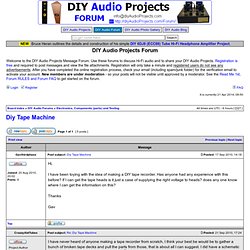

STEVE ALBINI. Join in to make a ReMix of a pop/rock song: Aarne Schmitt- Avant-garde Affection. Okay, here's my hour-or-so's worth.

The tune really isn't my thing (John Mayer inspired? Sounds like New Deep in a way. I canny stand John Mayer.) so this is how far I got before my attention span wavered, although I think it sounds pretty crisp and convincingly pop without sucking (a slight master EQ boost at 16k...I blame you for this Spede ). Went for an earthy, fairly 'natural' drum sound. There's layers and layers of delay underneath things. The delay thing throughout the song works marvelously! I use that thing on the master bus with the slowest attack and slowest release so that in the songs choruses it compressing 1-2 dBs.
My mentor has mentioned that people end up doing these kind of mixes when monitor they loud. Multitracks - Page 2. Tape Op - the Creative Music Recording Magazine. Acoustic Treatment for the Small Studio. As high-quality audio gear becomes ever more affordable, software emulations nip at the heels of some of the most coveted audio hardware, and much of the basic knowledge of the audio field becomes widely disseminated through the web, professional studios still offer more than a few major benefits.

The first among them is the skill and experience of their engineers. But not far behind is the quality of their rooms. There’s no easier place to make good mix choices than a well-tuned listening environment, and no better place to do a performance justice than a comfortable and well-balanced live room. RealTraps MiniTraps installed at Sterling Sound, NYC.
If you are building or upgrading an existing studio, it’s always always a good idea to set aside ample resources for room treatment and construction, as good tuning can improve the sound of any microphone and the accuracy of any set of speakers. Read more about how to acoustically treat a small room and watch DIY how-to videos on SonicScoop. Acoustic Treatment for the Small Studio. As high-quality audio gear becomes ever more affordable, software emulations nip at the heels of some of the most coveted audio hardware, and much of the basic knowledge of the audio field becomes widely disseminated through the web, professional studios still offer more than a few major benefits.

The first among them is the skill and experience of their engineers. But not far behind is the quality of their rooms. There’s no easier place to make good mix choices than a well-tuned listening environment, and no better place to do a performance justice than a comfortable and well-balanced live room. If you are building or upgrading an existing studio, it’s always always a good idea to set aside ample resources for room treatment and construction, as good tuning can improve the sound of any microphone and the accuracy of any set of speakers. Of course, not every production room can justify the budget for an elite acoustic designer or luxurious wood-paneled construction. Step 4: Diffusion. DIY Audio Projects Forum. Hi, Gavthirdphase wrote: If I can get the tape heads is it just a case of supplying the right voltage to heads?

Well, to help you get started in the right direction, tape heads do not go by voltage, but current through them. That's why record and erase heads have a low value resistor on the ground side to measure the current through them. To make matters interesting, this data was never published outside of the documents to the manufacturers they were made for. Audio / Video. 10 Myths About Normalization - Hometracked. The process of normalization often confuses newcomers to digital audio production.

The word itself, “normalize,” has various meanings, and this certainly contributes to the confusion. However, beginners and experts alike are also tripped up by the myths and misinformation that abound on the topic. I address the 10 most common myths, and the truth behind each, below. Peak Normalization First, some background: While “normalize” can mean several things (see below), the myths below primarily involve peak normalization. Peak normalization is an automated process that changes the level of each sample in a digital audio signal by the same amount, such that the loudest sample reaches a specified level. Normalizing is indistinguishable from moving a volume knob or fader. Some of the myths below reflect nothing more than a misunderstanding of this process. Myths and misinformation Myth #2: Normalizing makes a track as loud as it can be Consider these two mp3 files, each normalized to -3dB: